Back in the 1980's tennis was enormously popular and I was just young enough to believe that reading about the sport I enjoyed (and watching it religiously on TV) would help take my game to a higher level--you know, the ITF Satellite Circuit. Ha! Well, that didn't happen of course, but even so, when I finally did hang up my racquet for good I judged myself to be a fairly well versed, relatively solid 4.5 level player, and I'm more than pleased with that, all things considered.
"That's the trouble with tennis," complained Brenda, shaking the watch beside her ear. "Whenever you've got time off to play, the other person never has, and-- vice versa. You know? So you never do play. Wouldn't it be wonderful, though, if Nick can invent that tennis robot he's been promising, the machine or dummy that will return your strokes so that you can play alone?"
Paul Tankersley produced the cover art on the 1986 paperback from Zebra (lower).
"Marry me, Jill. Please marry me."
The girl in a white blouse and short tennis skirt dropped her racket on the lawn beside the long chair in which she had been resting after a strenuous game. the brilliant sun poured down on waves of shining auburn hair, on clear brown eyes and smiling tender lips in a vivid face deeply tanned.
She turned her head, looking in surprise at the earnest young man in the chair under the big, gaily striped umbrella. Chester Bennett's pleasant face was anxious as he returned her look.
"Mapleville is a nice village," he said persuasively. "You like it here, don't you?"
"Yes, but--"
"I could make you happy. I'd try very hard."
A slim tanned hand made a quick pleading gesture. "Chester, you're like a very dear cousin I'm terribly found of. But..."
 |
| CLICK TO ENLARGE |
King's Castle by Leslie Ames (Red Rose Romance No. 115), was published by Bantam in October, 1971. Ames is actually William Edward Daniel Ross (W. E. D. Ross), a Canadian, and one of the most productive fiction writers of all time. Here's why: Ross didn't even start writing until he was 48, but before he passed away at the age of 83 in 1995 he had published more than 300 novels under a variety of pseudonyms and genres.
Dreams in the Sun by Marsha Manning (Red Rose Romance No. 102), was published by Bantam in June, 1971. I couldn't find any biographical information about Manning online, but I did discover that her novel was first published in the UK by Ward Lock & Co in 1967, which probably makes her British by birth.
The cover art is fascinating because the artist, who was not credited but is probably either Stuart Kaufman or Gordon Johnson, likened Charlton Heston as his inspiration for Henry Farquharson. A good choice too because Henry's physical charisma is every bit as powerful as Heston's was. Interestingly enough, when Heston and his wife Lydia Clarke were living in Hell's Kitchen during the late 1940s they both worked briefly as artists models. I'm sure that Heston's rugged visage impressed the eye of every artist he posed for (Lydia's beauty the same!).
The Professional by Edwin Fadiman, Jr., is the story of the making of a male tennis champion, from the slums of his orphaned youth to the Bel Air mansion of his married adulthood. It's a helluva story too, fraught with tragedy and triumph, and one that speaks true to its time and the sport's new Open Era. It was published in paperback by Fawcett Crest in December, 1974, about a year after the hardback edition came out. Edwin Fadiman, Jr. (1925- 1994) was often overshadowed by his uncle Clifton Fadiman (1904- 1999), a famous radio and television personality, intellectual, author and editor, who while editing for Simon & Schuster turned Robert Ripley's newspaper cartoon Believe it or Not! into a bestselling book series. But Edwin the nephew had a productive literary career in his own right, as a radio and television writer, editor, reviewer, and, touché, a novelist. In addition to his opus on tennis he wrote six really good novels: The Voice and the Light (1949), The Glass Play-Pen (1956), An Act of Violence (1957), The "21" Screen (1960), Who Will Watch the Watchers (1971) and The One-Eyed King (1972).
Although not signed, the cover art was most likely produced by realist painter Peter Caras (1941-). When Caras was starting his career he purposely met Norman Rockwell, ultimately becoming his friend and associate. He was also mentored by the late great James Bama, and it's easy to see Bama's influence in most of Caras's early paintings.
Four male friends meet at a private tennis court every Saturday morning to play doubles. On Friday night the wife of one of the men starts partying with the others at a community pool while her husband is conspicuously absent. Her body is found the next day wrapped in plastic. But was she actually murdered? And by whom? After all, the tennis match went on as per usual.
Saturday Games was written by Brown Meggs and published by Fawcett Crest in January of 1976. It was nominated for an Edgar Award for Best First Novel in 1975, but lost out to Gregory McDonald's Fletch. Meggs (1931-1997) wrote his debut in between gigs as an EMI/Capitol Records executive, where he was instrumental in signing The Beatles to their first American recording contract in 1963. During his self-imposed hiatus from the music business he also wrote three other novels, each one being an ace, just like his first one. They are The Matter of Paradise (1975), Aria (1978), and The War Train (1981).
Canadian born Tom (Thomas John) Miller (1913- 2004) produced the cover art for Saturday Games. Miller chose not draw anything tennis related into his scene, but he will always get a favorable line call from me because he happens to be one of the finest realist painters of the 20th century. When Miller started illustrating paperback covers in the late 1950s he kept his pictures conventional to comply with what his art directors needed, i.e., dames, dudes, doctors and nurses in basic situational poses, plus he was still in the throes of learning. But by the time the 1970s rolled in Miller had developed his painting style so acutely that the words realism and gorgeous were one and the same.
Lee Head was born in Bartlesville, Oklahoma, and graduated from the University of Oklahoma. She wrote just one other mystery besides The Terrarium, titled Crystal Clear Case, and they both feature her unorthodox sleuth, Lexey Jane Pelazoni, a sixty-eight-year-old widow with a nose for trouble. Head also wrote the Golden Spur Award winning historical novel Horizon, which chronicles the exploits of an Oklahoma ranch family. Head died in 1983 from cancer while living in Santa Fe, New Mexico. Sadly, she was only 52 years old.
The front-page blurb reads like this:
THE NAME OF THE GAME WAS SUDDEN DEATH
The big time tennis tour had turned into a terror trip. One of the most luscious lady lobbers was mangled in the locker room, another met an even more gruesome end, and players suddenly found they needed more than the guts in the racquets to keep from quitting the courts.
That's when Dion Quince made the scene, using his tennis talents to gain entry into a world of sunlit sport and shadowy evil-- and his hard body and iron nerve to keep his end up in a game where love meant zero, lust scored high, players swung every way, and an unknown killer kept hitting winner after winner...
I get the impression that Rosenbaum would have liked for her book to become an updated annual. Popular Library published it as a paperback original in May, 1977, but they never reprinted it or any revised editions, so today it is a rather rare and perhaps even valuable in the eyes of some tennis fans. It's definitely an item from the 'old time-capsule'.
Is World Class (Popular, 1977) the best novel ever written about life on the tennis circuit? Well--considering that every paperback copy that I've come across has been read to near ruin (like mine here), I'm inclined to believe that, yes, maybe it is. The authors, Jane and Burt Boyar, certainly did their homework in preparation to writing their tome; two years traveling on the pro circuit taking notes and interviewing a who's who of the sport's best players, folks such as Butch Buchholz, Marilyn Bucholz, Cliff Drysdale, Roy Emerson, Pancho Gonzales, Rod Laver, Mary Laver, John Newcombe, Dennis Ralston, Tony Roche, Ken Rosewall, Pancho Segura, Fred Stolle, and Roger Taylor. They also interviewed the players wives and coaches--and attended a lot of lavish parties too! (Note: the cover image appears to be a photograph and not a painted illustration).
The Tennis Hustler (1978) is one of tennis's 'Holy Grails'. But not because it's one of the best novels ever written about the sport (hmm... don't think so), or because J. R. Pici might be the pseudonym of a famous writer (hmm... not likely), but strictly because it was the product of Major Books, a low-budget publisher who ran extremely low print runs. So finding a copy can be an impossible task, and I feel incredibly lucky to have stumbled across this one.
"The Queen and the winner of your final will be executed unless a suitable ransom is paid before your match ends. If anyone attempts to leave the royal box or the center court before the match ends, the executions will be carried out immediately, but will include both of you, not just one. Should any attempt be made to remove the Queen from the royal box, or provide her with cover in it, or get either of you off the court, many innocent spectators will die. Negotiations are in progress, have a good game."
"With an eye for catchy details and a tone that drifts blithely from cynical to-sentimental to downright silly, Brinkley keeps things moving right along without leaning too heavily on the non-plot. Result? A cheerfully vulgar, agreeably lousy, very professional chunk of good-natured easy-reading."
Birney Lettick (1919-1986) produced the cover art on Breakpoint. Lettick was a commercial artist whose portrait work and illustrations appeared regularly in and on magazines such as Time, Collier's, National Lampoon, Newsweek, and National Geographic. In addition to creating paperback covers he also produced movie posters for some of Hollywood's biggest films.
"With gratitude to the tennis friends of our family, who helped make it possible for our children to win more than 500 tennis trophies and three college scholarships: Al Teeter, Norman MacDonald, Frank Voigt, Bob DeHaven, Dick Allen, Bill Kuross, Betty and Warren Swanson, Connie Custodio."
It was a long way from tennis pro at a small Midwestern country club to the big time, and Jack Evans was a young man in a hurry. His success on the tennis court was equaled by his prowess with women, but for Jack sex was just a sideline. He knew that, with the proper breaks, he could be US Open Champion, and he wasn't going to let his love life interfere with his career. If there was a short route to the top, he'd take it, even if he had to destroy the girl he loved in the process!'
THE GAME: A "sudden death" tennis grudge match...
THE STAKES: One million dollars, winner-take-all...
THE PLAYERS:
Alex Wrangler: All his life he'd used tennis the way he used women--fiercely and artfully. Now the aging champ was trying for a dazzling comeback. But first he had to face the new contender--and a new kind of love.
Fletcher Sampson: The Australian kid with a golden style. By 26, he'd ripened from an eager-eyed teenage athlete to a rock-hard pro, plying the dirty ways of Alex Wrangler--backhanded sex and smashing violence--even better than the big man himself.'
"WHEN YOU FORFEIT THE MATCH IN THE GAMES HITCHCOCK PLAYS... IT'S FOREVER."
The China Cottage by August Derleth
Killed in Kindness by Nedra Tyre
You Can't Be Too Careful by James Holding
Murder Delayed by Henry Slesar
A Pattern of Guilt by Helen Nielsen
Weighty Problem by Duane Decker
Willie Betts, Banker by Mike Brett
Bus to Chattanooga by Jonathan Craig
The Feel of a Trigger by Donald Westlake
Captive Audience by Jack Ritchie
Room to Let by Hal Ellson
Double Trouble by Robert Edmond Alter
Heist in Pianissimo by Talmage Powell
Wish You Were Here by Richard Hardwick
Contraband by James Holding
For Every Evil by Douglas Farr
You Can't Win 'Em (at) All by Ed Lacy
Murder in Mind by C. B. Gilford
Charley's Charm by Alice-Mary Schnirring
Murder Door to Door by Robert Colby
Ransom Demand by Jeffrey M. Wallman
I'll Race You by Fletcher Flora
"I Am Not a Thief, Mr. Kester" by Gilbert Ralston
Mousetrap by Edwin P. Hicks
Mildly Murderous by Elijah Ellis
An Element of Risk by Richard Deming
A Neighborly Observation by Richard Hardwick
 |
| CLICK TO ENLARGE |
 |
| CLICK TO ENLARGE |
Roberta Leigh was the pseudonym, and assumed name, of Englishwoman Rita Lewin Shulman (1926- 2014). It was one of four names that she used while writing more than 160 novels, most of which were romances. She was also a painter, and an accomplished British television writer, producer and composer. Her novel Love Match was first published in 1980 (not shown) and then reprinted twice by Worldwide. The Worldwide copy at the top is from November, 1982, and while the cover art is not signed or credited, I believe it was produced by Charles Geer, an accomplished illustrator known for his distinctively styled gothic romance covers. The copy underneath is from June, 1983, and its cover art was produced by Victor Gadino, a prolific realist painter who began his career in the mid-1970s. Why Worldwide would shell out money to two different illustrators on the same title within the space of only a year is something that only those involved can answer.
 |
| CLICK TO ENLARGE |
So let's crack open a new can of balls and keep playing!
Death on the Center Court by George Goodchild was first published in the US by Green Circle in 1936 (seen above), and in the UK by Hodder & Stoughton in 1937. But finding a copy to buy of either edition is tough as only three are currently listed online and borrowing is even tougher because there are no lending libraries in the US that own. But there is a third option: Fly to England where you can reserve a copy to read "in house" at the Kenneth Ritchie Wimbledon Library, which is part of the Wimbledon Lawn Tennis Museum. And at the same time you will have one heckuva limey vacation.
George Goodchild (1885-1969) was a prolific British writer about whom very little is known. It is known however that he published 135 novels, some under the pseudonyms Jesse Templeton, Wallace Q. Reid, and Alan Dare, but most were published under his own name. He also published 61 collections of short stories. The jacket art on Green Circle edition was produced by Carl Cobbledick. He was extremely prolific too, but like Goodchild very little if anything is known about his personal life.
'The championship within his grasp, Wynbolt, the sensational Australian tennis star, drops dea on the center court at Wimbledon. And Inspector McClean is watching the match from one of the boxes--right on the spot to leap into one his whirlwind investigations that spares neither the secrets of private life nor the delicate feelings of his friend's only daughter. McClean turns up a heap of dirt about the Australian thunderbolt and his lady admirers. But the murder itself, which appeared to be a simple heart failure, begins to be solved only when the Inspector settles down in a quiet county cottage to observe the strange drama in a nearby house, which has a mystery of its own...
Leo Manso produced the cover art on the very first hardback edition of Carr's The Problem of the Wire Cage (top & middle). It was published by Harpers in 1939. Manso's footprints are much more defined than on that later published Bantam seen at the beginning. The 1940 British edition from Hamish Hamilton also emphasizes the footprints (bottom). If you're a Carr fan which edition would you prefer, or maybe you'd want to own them both, like me! (Note: the full dust jackets here are facsimiles that can be purchased for twenty-five dollars each plus s/h (books not included) from Facsimile Dust Jackets LLC.
Bantam's very first paperback edition of The Problem of the Wire Cage was published in 1948. Gilbert Fullington produced the cover art. Fullington certainly emphazied the "wire cage," but without the woman's white outfit you wouldn't know this is a tennis related mystery. Pan's paperback edition was published one year later but their uncredited cover art stayed with both the red clay and the footprints.
A bloody body lying on a tennis court would imply that this murder mystery has more to do with tennis than just mere coincidence, but then again, perhaps not. Learning what really gives here is not easy because Here Lies Blood (Bobbs Merrill, 1942) is a really tough book to obtain; copies for sale are exceedingly scarce and libraries are stingy to loan, and thus far only the NY Times has reviewed it but as we all know they are off-limits to non-subscribers. The jacket artist is also not known. What I do know about the author, M. M. Mannon, is this: The name is a pseudonym for two sisters, Martha and Mary Ellen Mannon (Mary may have been known to some as Lucy). Martha, apparently, was one of the first women admitted to Stanford University's School of Medicine but had to forestall her studies because because she contracted tuberculosis. During her long recovery she and Mary co-wrote this mystery together, and eventually two more: Murder on the Program 1944), and The Corpse in the Elevator (1956). Martha lived in California all her life and was married to Everett Arthur "Joe" Coe, a career Foreign Service officer with stints in post-WWII Poland and Haiti.
[*Addendum: I was finally able to read this novel--and no, the private tennis court is not a factor other than that was where the victim, a handsome, vital, clever, college-age young man, was bludgeoned to death while waiting to play a game of tennis with his betrothed. The pool of suspects all derive from the household and their associates: a clinging mother, her handicapped son (who is the brother of the dead man), the aforementioned fiance, a housekeeper, a doctor and his wife, a judge, and a pair of friends--just enough people to confuse me into reading some chapters twice. The story and plot were good but I was unsatisfied with the romantic entanglement at the conclusion--it just felt forced and even awkward.]
Going Steady by Anne Emery is a typical teen relationship novel aimed at girls. It was first published in paperback by Scholastic Books in 1961, with cover art and interior illustrations by Bud Parke (top), and then reprinted many times. Stan Hunter produced the cover art on the 1967 reprint (bottom).
Set Point, A Win Hadley Sport Story by Mark Porter, is a typical teen sports novel aimed at boys. It was published first in hardback by Simon & Schuster in 1960 (top), in then in paperback by Tempo in 1966 (bottom). The jacket art on the hardback edition is not credited, but the paperback cover art was produced by John McDermott, who generally signed his paintings with the initials "MCD." McDermott (1919-1977) was a steady magazine illustrator in addition to producing scores of cover art for paperbacks, his most famous being perhaps Jack Finney's The Body Snatchers (Dell, 1955).
U.S. born artist and illustrator Tom Adams is noted for producing dozens of distinctive Agatha Christie covers, on both sides of the Atlantic, including this simple but very effective one for Cat Among the Pigeons, published by Fontana (UK) in 1971.
'Chuck Chandler arrives in Key West, as many people do, at the end of his rope. He has, in turn, blown a career as a top tour tennis professional and a series of teaching jobs at plush clubs, usually because he has been unable to keep his hands of his female students. At Key West's Olde Island Racquet Club, he yields to temptation once again, this time for the beautiful Clare Carras, who is married to an enigmatic older man with no apparent past and who turns out to be a great deal more than the tennis pro can handle. Suddenly, the easygoing Chuck is in over his head, suspected of murder and on the verge of losing not only his modest career and all of his possessions but his freedom as well. Enter Tommy Sculley, a former New York Police Department homicide detective, augmenting his pension with a job on the Key West force, and his neophyte partner, Daryl Haynes, who may be smarter than he looks. The two detectives find themselves barely afloat in a shark-infested investigation that stretches from the Florida Keys to Los Angeles and back, involving no only the treacherous Clare but a furious West Coast mob boss who is determined to get back something that belongs to him and doesn't care who he has to kill to do it.'
Bjorn Borg won eleven Grand Slam single titles in eight years and only lacked a US Open title, losing in four finals due to what insiders have suggested were mitigating circumstances--but also because he faced tough competition, and trust me on this; if Federer, Nadal or Jokovic had played in the 1970's and 80's they wouldn't have a third as many titles as they do. I did have an opportunity once to see Borg play John McEnroe in an exhibition, but work prevented me from getting to the box office in time. I did not make that same mistake with Ashe--when his tickets went on sale I was first in line, work be damned.
Arthur Ashe, Portrait in Motion by Arthur Ashe & Frank DeFord was published in paperback by Ballantine in 1976. Bjorn Borg by Bjorn Borg & Eugene L. Scott was published in hardback by Sidgwick & Jackson of London in 1980 (it was published in the US simultaneously by Simon & Schuster).
What better way to end this post than by showing some great tennis covers drawn by Clarence "Boo" Doore (1913-1988). Doore, an outstanding realist painter, composed figures and faces with an almost signature look about them. During his career he produced hundreds of action-oriented illustrations for men's magazines, pulps, advertising, comics, hardbacks, paperbacks, and of course an occasional program for the United States Lawn Tennis Association.
[© September, 2018, Jeffersen.]
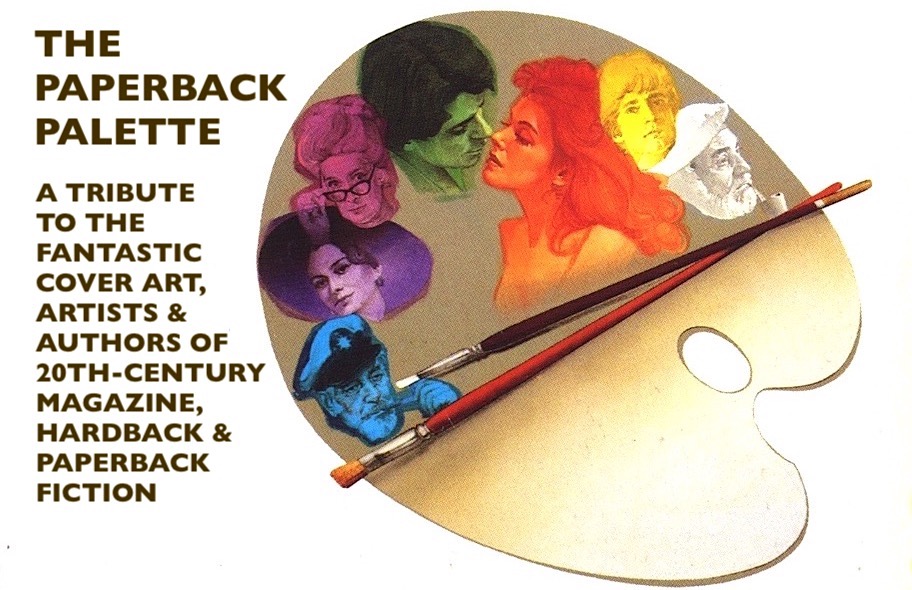













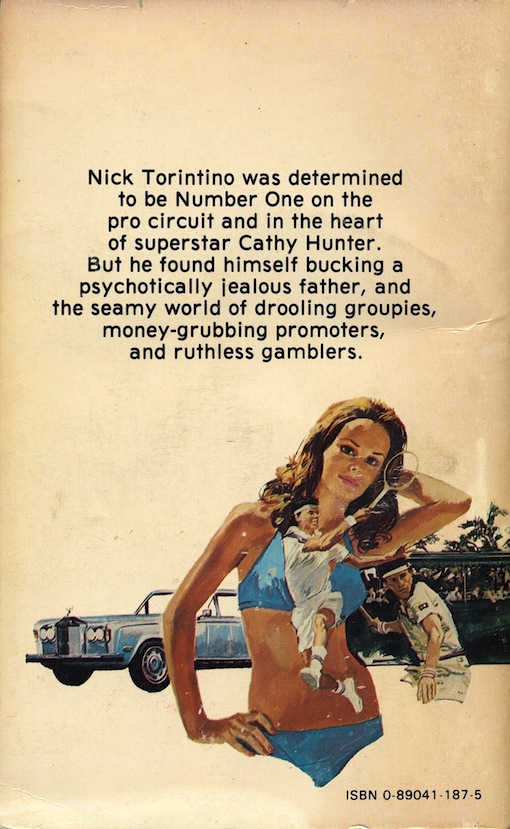






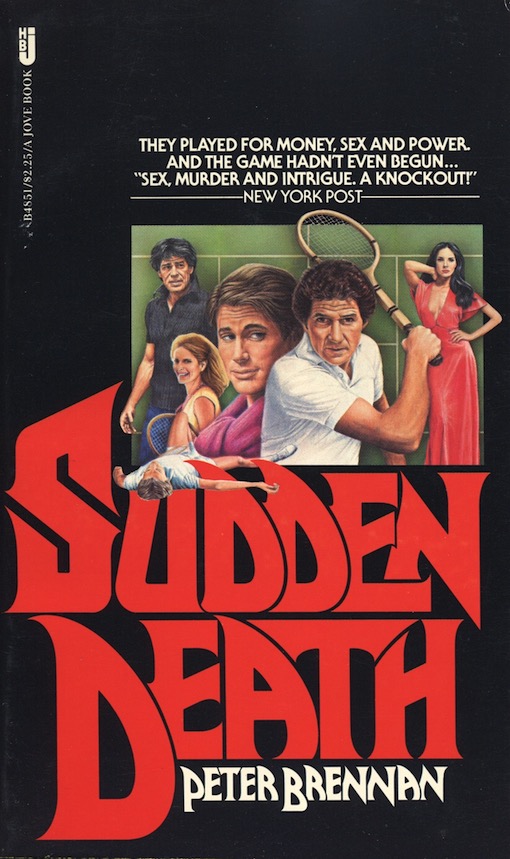












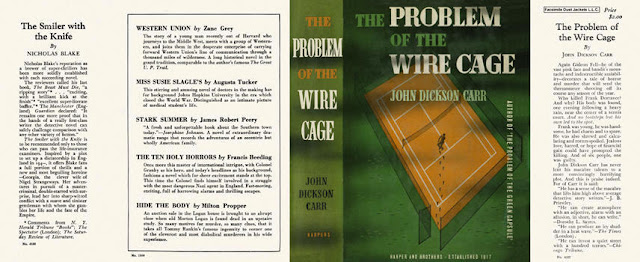
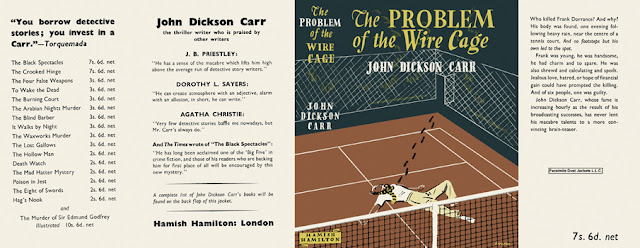






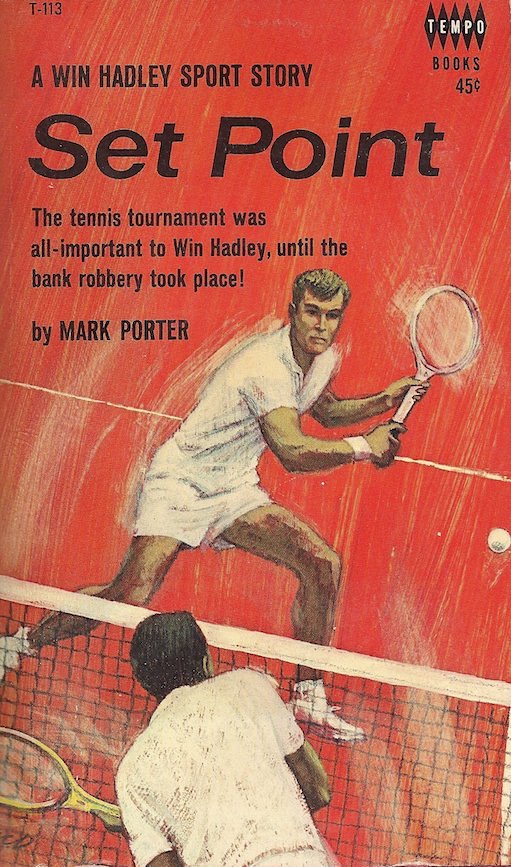











2 comments:
Great blog! Just wanted to comment on your cover artist guess for "The Terrarium".
Although I can't officially confirm it was one of Charlie's watercolors, I'm 99.99% sure you're right! I can spot his work immediately, as I was one of his protegees, and we even had the same agent. The Leffs represented many of the top paperback artists throughout the 80's and 90's. Ron Lesser was there, too!
I miss the days of painted covers, so thanks for keeping this work alive!
Anonymous:
Yeah, I was pretty sure about Gehm and Terrarium, and of course you were fortunate to have had such a great mentor. I've collected a whole bunch of his covers so I probably should do a post on him at some point. Maybe I can pull one together for this July or August.
Post a Comment